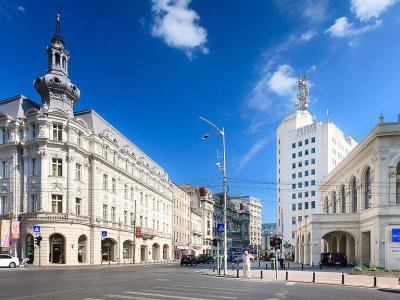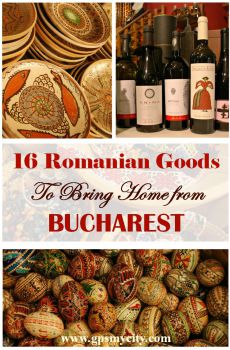Calea Victoriei (Victory Avenue), Bucharest (must see)
Victory Avenue (Calea Victoriei) is one of Bucharest’s most historic and elegant boulevards. Originally a simple trade route connecting Bucharest to the city of Brasov, it was transformed into a paved thoroughfare in the late 17th century under Prince Constantin Brancoveanu. The road was renamed “Calea Victoriei” in 1878 to commemorate Romania’s victory in the War of Independence, and has since become a symbol of the city’s modern ambitions and architectural grandeur.
Lined with a mix of Belle Époque mansions, interwar modernist buildings, and imposing institutions, the avenue reflects the city’s shifting styles and eras. Notable landmarks include the Romanian Athenaeum, the National Museum of Art (formerly the Royal Palace), the CEC Palace with its eclectic dome, and the Revolution Square-an important site during the fall of communism in 1989. The street also hosts several high-end hotels, shops, and cafes, blending culture with commerce in a uniquely urban setting.
Victory Avenue is best explored on foot, especially during weekends when parts of it become pedestrian-only. The blend of heritage facades, tree-lined sidewalks, and occasional street performances creates a leisurely atmosphere ideal for strolling and people-watching. While the traffic and noise of the city persist nearby, the boulevard manages to offer moments of elegance and calm amid the bustle.
For visitors interested in architecture, history, or simply soaking in the spirit of Bucharest, Victory Avenue offers a continuous narrative-one that ties the past to the present with each step taken along its route.
Lined with a mix of Belle Époque mansions, interwar modernist buildings, and imposing institutions, the avenue reflects the city’s shifting styles and eras. Notable landmarks include the Romanian Athenaeum, the National Museum of Art (formerly the Royal Palace), the CEC Palace with its eclectic dome, and the Revolution Square-an important site during the fall of communism in 1989. The street also hosts several high-end hotels, shops, and cafes, blending culture with commerce in a uniquely urban setting.
Victory Avenue is best explored on foot, especially during weekends when parts of it become pedestrian-only. The blend of heritage facades, tree-lined sidewalks, and occasional street performances creates a leisurely atmosphere ideal for strolling and people-watching. While the traffic and noise of the city persist nearby, the boulevard manages to offer moments of elegance and calm amid the bustle.
For visitors interested in architecture, history, or simply soaking in the spirit of Bucharest, Victory Avenue offers a continuous narrative-one that ties the past to the present with each step taken along its route.
Want to visit this sight? Check out these Self-Guided Walking Tours in Bucharest. Alternatively, you can download the mobile app "GPSmyCity: Walks in 1K+ Cities" from Apple App Store or Google Play Store. The app turns your mobile device to a personal tour guide and it works offline, so no data plan is needed when traveling abroad.
Calea Victoriei (Victory Avenue) on Map
Sight Name: Calea Victoriei (Victory Avenue)
Sight Location: Bucharest, Romania (See walking tours in Bucharest)
Sight Type: Attraction/Landmark
Guide(s) Containing This Sight:
Sight Location: Bucharest, Romania (See walking tours in Bucharest)
Sight Type: Attraction/Landmark
Guide(s) Containing This Sight:
Walking Tours in Bucharest, Romania
Create Your Own Walk in Bucharest
Creating your own self-guided walk in Bucharest is easy and fun. Choose the city attractions that you want to see and a walk route map will be created just for you. You can even set your hotel as the start point of the walk.
Bucharest Introduction Walking Tour
Bucharest, the capital and cultural center of Romania, is one of the largest cities in Southeastern Europe.
The name București has an unverified origin. Tradition links it to the guy named Bucur, who (according to various legends) was either a prince, outlaw, fisherman, shepherd or a hunter. The Romanian word “bucurie” means joy (happiness), which in turn explains one of Bucharest's... view more
Tour Duration: 2 Hour(s)
Travel Distance: 3.7 Km or 2.3 Miles
The name București has an unverified origin. Tradition links it to the guy named Bucur, who (according to various legends) was either a prince, outlaw, fisherman, shepherd or a hunter. The Romanian word “bucurie” means joy (happiness), which in turn explains one of Bucharest's... view more
Tour Duration: 2 Hour(s)
Travel Distance: 3.7 Km or 2.3 Miles
Old Town Walking Tour
The Historical Center of Bucharest, or the Old Town, as the locals habitually refer to it, is one of the most beloved and attractive areas in the Romanian capital. The neighborhood is really beautiful a place to visit, and you can walk into it pretty much from anywhere in central Bucharest. Ion Constantin Brătianu Boulevard crosses the historic heart of the city from Piata Universitate... view more
Tour Duration: 2 Hour(s)
Travel Distance: 1.9 Km or 1.2 Miles
Tour Duration: 2 Hour(s)
Travel Distance: 1.9 Km or 1.2 Miles
Useful Travel Guides for Planning Your Trip
16 Uniquely Romanian Things To Buy in Bucharest
Nicknamed "Little Paris", today's Bucharest is the capital of a vibrant European nation, known as Romania, with lots of history and great cultural heritage - spanning from centuries-old rural traditions to New Wave cinema. Keen on rustic stuff, Romanians carefully preserve their...






